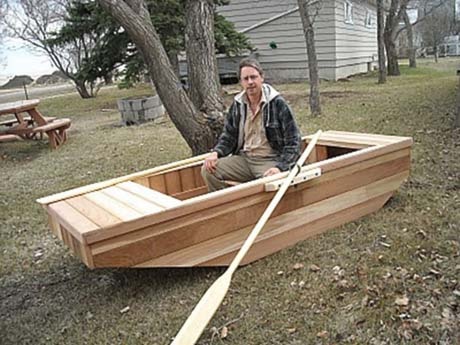At the end of this month a unique flat-bottomed scow will be slipped into the Red Deer River to start an expedition that could be dubbed Dinosaur Hunting: Old School.
The launch will be the culmination of eight years of preparation by long-time paleontology technician Darren Tanke, who came up with the idea of celebrating the 100th anniversary of the first major dinosaur-hunting expedition on the Red Deer River by building a replica of the nine-metre-long, four-metre-wide shallow draft boat that Barnum Brown and his team from the American Museum of Natural History used to explore the area in 1910.
The craft will be equipped with tent, wood stove and hundreds of period tools and other day-to-day items to create a floating time machine.
In a field where history is usually thought of in terms of tens or hundreds of millions of years, Tanke became fascinated with a period only a century removed from the present.
It was a period when dinosaur hunters in their woolen and cotton clothing, armed with only the most basic tools made an astonishingly string of discoveries along the river.
“I just thought it would be a neat project to reenact, to relive, the 1910 expedition,” the 49-year-old from his Drumheller home recently.
“The 1910 expedition was the first real dedicated expedition where people who really knew what they were doing and were after skeletons of dinosaurs specifically came with a pretty big agenda as to what they wanted to do.
“And they did it, and that’s what set off the great Canadian dinosaur rush.”
While Tanke is the longest serving employee at the renowned Royal Tyrell Museum, with more than 30 years experience, the expedition is a personal quest. He has sunk more than $9,000 of his own savings into his dream and will use vacation time to make the five-week journey beginning June 29 from the boat launch near Bower Ponds to his destination at Dinosaur Provincial Park near Brooks on Aug. 7 when a public celebration of the journey will be held. Additional funding has come from a number of sponsors including Calgary’s Dinosaur Research Institute.
Joining him on his expedition will be nearly two dozen researchers, paleontology students and other dinosaur enthusiasts, who will come aboard for a few days each. Tanke’s girlfriend Patty Ralrick, a University of Calgary paleontologist, has signed on as cook and is already perfecting century-old recipes that can be cooked on a wood stove.
A children’s author will also join him and they hope to turn his quest into a book for children encouraging them to pursue their passions and follow their imaginations.
The expedition is more than an exercise in taking a walk in the hob-nailed shoes of early dinosaur hunters. It is also meant to be a voyage of discovery.
More than a half-century has passed since any extensive dinosaur hunting expeditions have scoured the escarpments along the river for signs of ancient bones and fossils.
“A lot of these areas along the river have never been systematically surveyed like they were by scow expeditions between 1910 and 1916.
“Most of the subsequent work has been picking a specific area and kind of blitzing it for a month or two, or in some cases just for a few days.”
Since about 1950 most of the dinosaur hunting as amounted to “pin-prick looks” of short duration and of nowhere near the scope he plans.
“I’m hoping — I shouldn’t even say hoping — because I’m pretty confident we’ll find more dinosaur bones, new dinosaur bone beds and things like that.”
In an environment where wind and water can wear away a centimetre of sandstone a year, 60 to 70 cm of the banks may have been carved away since the last big expeditions floated by.
“The erosion rate of the Badlands is quite high. We often say to the public, one rain and you can find something new.”
The lazy journey down the river won’t allow time for any proper excavation so all discoveries will be photographed, mapped with GPS technology and left to be studied at a later date. The exact distance hasn’t been determined but the trip will be in the neighbourhood of 400 km.
The days of Barnum Brown, when bones were chipped and loaded into wagons as fast as they could be found are gone. Modern dinosaur hunters take a much more cautious and deliberate approach.
Tanke also plans to explore dinosaur bone quarries left by previous teams. He has spent years researching sites by combing old newspaper accounts, scouring archives and other sources and has compiled a list of three dozen former bone sites. In many cases, bones and other valuable material can be found in the “trash” left behind by those expeditions.
A blog has already been set up at http://2010dinohuntingbyboat.blogspot.com. Tanke intends to update it regularly during his journey.
pcowley@www.reddeeradvocate.com
